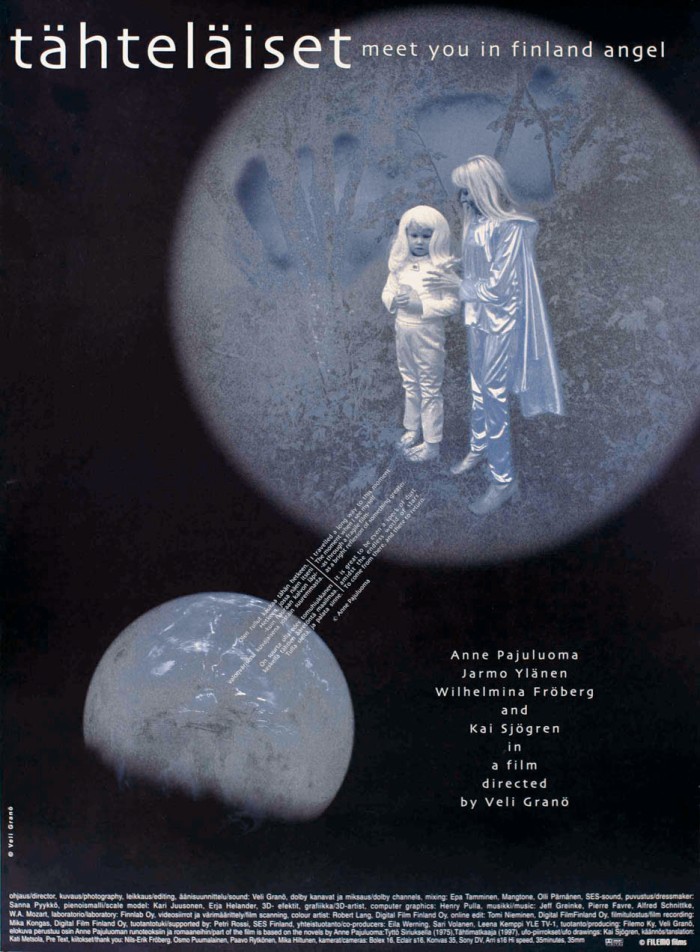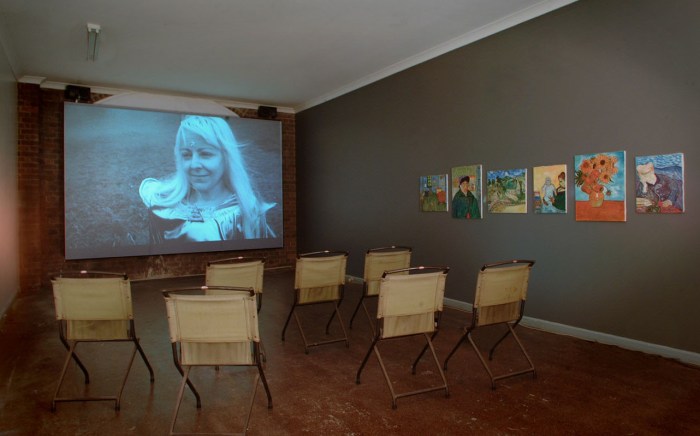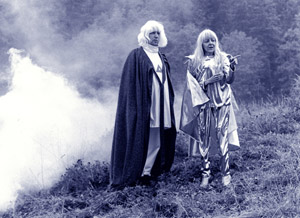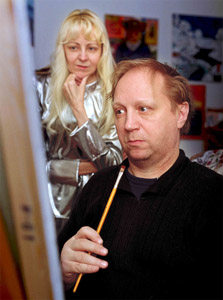Tähteläiset/Meet You in Finland Angel 2003. Finnish in finnish text below.
Meet you in Finland, Angel (2003) combines both Anne Pajuluoma’s and her spouse’s, Jarmo Ylänen’s life stories. Jarmo is a self taught artist who believes he is painting his works in collaboration with Vincent van Gogh. The work reconstructs the unique experiences of Anne and Jarmo, the representatives of “star people”, who lead their unordinary, materially extremely meagre lives in the midst of miracles. It is estimated that on our planet there are tens of thousands of star people, to whom one or both of their parents might be visitors from space. Some of the star people as residents of faraway planets have moved to the Earth while many of them do not know their origins.

Tähteläiset – Meet You in Finland Angel
Film, 35mins, 35mm colour/b&w/dolby digital 5.1/1:1,85
“Tähteläiset”-start people believe that they are of extraterrestrial descent. Either or both parents of a start people can be a visitor from outer space. Some of the start people are inhabitants of distant planets that have moved to Earth. There are many start people who are unaware of their origins, but it is estimated (according to New Age publications) that up to tens of thousands of them live on Earth. Background
In addition to films, Veli Granö has made documentary works of photography and installations. He received the Finnish State Prize for Photography in 2002. The present film continues the collaboration between Granö and Anne Pajuluoma that resulted in video pieces and the installation exhibition “Star Dweller” (presented at Galleria Hippolyte in Helsinki in 2000, the Pori Art Museum in Finland in 2001, and the Sydney Biennale of 2002 among other venues). The film “Star Dwellers” is the result of three years’ work and a process of close and intimate collaboration between Granö and the leading characters. The present film can be regarded as a sister piece to “Strange Message from Another Star” from 1999. The latter was about the feelings of alienation felt by a man – Paavo Rahkonen – on Earth and of his attempts to move to another planet. The present film focuses on the story of a woman with a similar sense of being alien and of her child lost to another planet.
The characters
Writer Anne Pajuluoma and the artist Jarmo Ylänen of Helsinki do not lead quite a normal life. Their existence, frugal and meagre in material terms, is surrounded by a world of miracle. Their daughter, lost and sorely missed, is growing up on the planet Sirius, and their everyday life is secured by unexpected interplanetary visitors. Anne likes to stay at home spending her time writing poems, remembering a few visits to Sirius and looking after Jarmo, whose health has been eroded by work.
Working life in transition
The individual’s experience of reality is related to be being able to see the surrounding world as a meaningful system that provides constructive opportunities. The core problem addressed in the film is the situation where an ever-larger sector of the population lacks everyday prospects and has lost realistic hopes necessary for life.
In recent years, major change and transition have taken place in working life in Finland. Growing numbers of jobs have been made temporary, or they have been “outsourced” to become insecure entrepreneurship.
In his struggling against this process of marginalization, Jarmo represents the workforce now forgotten by the welfare society. He works outside the security network provided by society or an employer, completely without days off, annual holidays or sick leave, unemployment security or other benefits that used to be a natural part of any job. Nor does his job provide any pension benefits. Work without the structures securing the position of the worker is an example of the ruthlessness of the “new economy”. While still new in Finland, a working people like Jarmo are already a recognized part of a problematic known the world over.
Although years of work with no holidays or days off have undermined Jarmo’s health, his frustrated life of endless working days and meagre income gains light from a connection with Vincent van Gogh. Despite his poverty, van Gogh created some of the core works of the history of art and enduring messages of his trying personal experiences. Jarmo paints new versions of works of art that are close to him, receiving detailed instructions in his dreams, perhaps straight from van Gogh himself.
Jarmo’s role and existence as an artist do not suit the prevailing conception of art. But a look at his works opens up a new, unconventional perspective on the debate over originality and the copy that was launched in postmodern art theory. Jarmo’s art also shows how a copy of a work can entail unique values, and his example may even be a model of a new kind of artistry.
Beliefs creating a new ethic
The world appears to be embroiled in an unprecedented process of global change. Understandable concern over the upheaval of values and social structures is a source of confusion for people in all cultures, but it will also engender a struggle to bring about new ethical and moral values. The construction of new values may even require a change in religion, the core of the moral system of the community, or the emergence of new kinds of religions.
The loss of belief in the future is countered by completely new spiritual and intellectual phenomena. In the markets of a boundless economy free of almost any rules, everyone is responsible for his or her own happiness and continually threatened livelihood. Accordingly, the “markets” of religion have also opened up for everyone to seek an experience of the sacred for personal needs. For many people in Finland security is no longer an everyday occurrence, and Lutheran Christianity has in many ways been purged of the mysticism of the sacred. In the market of religious alternatives, a person’s choice of belief is no longer necessarily dictated by tradition, but instead by the personal and sometimes highly transitory preferences of religious orientation.
“Star Dwellers” tells of how people experiencing insecurity still make recourse to forces lying beyond rational culture. The Enlightenment dream of belief making way for victorious reason and order has reverted to the return of miracles, increasingly incredible worldviews and to cosmologies revolving on a personal plane.
The shifting of the horizon of hope to somewhere beyond the known world is already a widespread cultural phenomenon. The New Age movement and its fantastical theories are gaining popularity all over the world. But if it reflects the disintegration of deep cultural structures, it is also a sign that the culture of consumerism and material possessions is gradually being replaced with new, non-material values.
The leading characters’ conception of their special cosmic pedigree, their “star-dwellerness”, should perhaps be understood as an example of global change in religious practices.
On the means of the film
“Star Dwellers” is based on a dialogue of documentary and fictive scenes. The documentary video material (mini DV) presents the everyday life of the leading characters, while the 16mm black-and-white film material expands documentary reality towards the imaginary world of the characters. The film also contains 35mm footage in colour. The alternation of different film and video materials establishes visual layers in the film that seek to interpret the different levels of reality experienced by the characters and the lack of any boundaries when moving between them.
The use of documentary expression, here to present a reality appearing to be almost incredible, required the inclusion of fictive sequences. The film contains acted and staged scenes, and also a reconstruction of Anne’s visit to the planet Sirius C as told by her.
The implausible in art and film
Traditionally, and for natural reasons, the esoteric and all its attendant phenomena have been in the margins or in the sphere of popular commercial culture. Awareness of the unsolved nature of phenomena outside the domain of science is nonetheless an intellectual challenge that a thinking person cannot completely ignore. Ultimately, this is about the possibilities of a whole and, as far as we know, infinite universe. The magnitude and interest of the question will, of course, not diminish through a focus on humanity and the self-destructiveness and horror of its behaviour.
The film does not enter into any debate on the validity of incredible phenomena. It focuses on its leading characters and their special nature, narrative, fate and dreams. The world of miracles is accepted and lived in with a positive attitude as related by the characters – as tales and attempts to establish positive meanings in an everyday existence that can be so inordinate in its demands.
the story of Anne Pajuluoma and Jarmo Ylänen little Mira: Wilhelmina Fröberg angel, UFO –drawings: Kai Sjögren costumes: Sanna Pyykkö scale model: Kari Juusonen, Erja Helander 3D-artist, digital compositor: Henry Pulla music: Jeff Greinke, Pierre Favre, And the Lefthanded, W.A. Mozart mixing: Epa Tamminen, Olli Pärnänen, SES-sound colour artist: Robert Lang, Digital Film Finland Oy online edit: Tomi Nieminen, Digital Film Finland Oy print: Mika Kongas, Digital Film Finland Oy, Timo Nousiainen, Finnlab Oy laboratory: Finnlab Oy cinematography, editing, sound, director Veli Granö supported by: Petri Rossi, Finnish Film Foundation, SES co-producers: Eila Werning Sari Volanen Leena Kemppi, Yle, TV-1 festival contribute, print source: Marja Pallassalo
producing: Veli Granö, FILEMO KY 2003
The film is partly based on the poetry anthologies of Anne Pajuluoma and her novels Tyttö Siriuksella (Girl on Sirius, 1975) ja Tähtimatkaaja (Star Traveller, 1997). Premiere, DocPoint-festival, Helsinki 2003
Article © Veli Granö

Elokuvasta poistetun kohtauksen alku.
Tähteläiset – meet you in Finland Angel
Tähteläiset uskovat polveutuvansa maan ulkopuolelta. Heidän toinen tai molemmat vanhempansa voivat olla vierailijoita avaruudesta. Jotkut Tähteläisistä ovat maan päälle siirtyneitä kaukaisten planeettojen asukkaita. Moni tähteläinen ei tunne alkuperäänsä, mutta heitä lasketaan (New Age -alan lehtien mukaan), olevan maapallolla ehkä jopa kymmeniätuhansia.
Dokumenttielokuva 35min, 35mm väri/mv, dolby digital 5.1/1:1,85
Ensiesitys/premiere: DocPoint- festivaali Helsinki 2003
Ohjaus, kuvaus, käsikirjoitus, leikkaus, äänisuunnittelu: Veli Granö
Dolby kanavat ja äänen miksaus: Epa Tamminen, SES-sound Olli Pärnänen
Puvustus: Sanna Pyykkö
Pienoismallit: Kari Juusonen, Erja Helander
Musiikki: Jeff Greinke, Pierre Favre, And the Lefthanded, W.A. Motzart
3D- efektit, kuvankäsittely: Henry Pulla
Videosiirrot ja värimäärittely: Robert Lang / Digital Film Finland Oy
Laboratorio: Finnlab Oy
Online edit: Tomi Nieminen / Digital Film Finland Oy
Filmitulostus: Mika Kongas / Digital Film Finland Oy
Tuotantotuki: Petri Rossi / Suomen elokuvasäätiö SES
Yhteistuotanto: Eila Werning, Sari Volanen, Leena Kemppi / YLE TV-1
Tuotanto: Filemo Ky
Elokuva perustuu osin Anne Pajuluoman runoteoksiin ja romaaneihin
Tyttö Siriuksella (1975) ja Tähtimatkaaja (1997)
Palkinnot: Risto Jarva palkinto, Tampereen kansainväliset elokuvajuhlat, 2003
Yleistä
Granö on tehnyt elokuvien lisäksi dokumentaarisia valokuva- ja installaatioteoksia. (Valokuvataiteen valtionpalkinto 2002) Tähteläiset elokuva muodostaa jatkoa Granön ja Anne Pajuluoman yhteistyölle, joka tuloksena on syntynyt myös muutamia videoteoksia ja installaationäyttely “Tähteläinen” (mm. Galleria Hippolyte Helsinki 2000, Porin taidemuseo 2001, Sydney biennale 2002). Tähteläiset -elokuva onkin Veli Granön lähes kolmen vuoden työn ja päähenkilöiden kanssa tehdyn tiiviin ja intiimin yhteistyön tulos. Nyt valmistuneen elokuvan voi nähdä myös 1999 valmistuneen “Ihmeellinen viesti toiselta tähdeltä”- elokuvan sisarteoksena. “Ihmeellinen viesti toiselta tähdeltä” käsitteli miehen –Paavo Rahkosen vierauden kokemusta maapallolla ja yritystä muuttaa toiselle planeetalle asumaan. Nyt keskeisenä kohteena on vierauden tunnetta potevan naisen ja toiselle planeetalle menetetyn lapsen tarina.
Päähenkilöistä
Helsinkiläisten kirjailija Anne Pajuluoman ja taiteilija Jarmo Yläsen elämä ei ole aivan tavallista. Aineellisesti niukkaa ja ankaraa elämää ympäröi ihmeiden maailma. Menetetty ja kaivattu tytär varttuu Sirius –planeetalla ja arkea turvaavat odottamattomat vierailijat muilta planeetoilta. Anne on viihtyy kotona ja aika kuluu runoja kirjoitellen, muutamaa vierailua Siriuksella muistellen ja työn kuluttaman Jarmon terveydestä huolehtien.
Työelämän murros
Yksilön kokemus todellisuudesta on sidoksissa hänen mahdollisuuksiinsa nähdä ulkomaailma mielekkäänä ja itselleen rakentavia mahdollisuuksia tarjoavana järjestelmänä. Elokuvan keskeinen kysymysasettelu liittyykin arjen näköalattomuuden ja elämälle tarpeellisten realististen toiveiden etääntymisestä yhä suuremman kansanosan tavoittamattomiin.
Suomalainen työelämä on kokenut viime vuosina suuren murroksen. Yhä useampi työsuhde on muuttunut tilapäiseksi tai työpaikka on “ulkoistettu” suojattomaksi yrittäjyydeksi.
Työelämästä syrjäytymistä vastaan kamppaileva Jarmo edustaa hyvinvointivaltion unohtamaa työvoimaa. Hän vuokraa Helsingin matkustajasatamassa tavaran kuljetuskärryjä matkailijoille. Hän työskentelee alipalkattuna yrittäjänä ilman työnantajan tai yhteiskunnan tarjoamaa turvaa, kokonaan ilman vapaapäiviä ja vuosi- tai sairaslomia, työttömyysturvaa ja muitakaan työpaikkaan ennen luonnollisesti liittyneitä etuja. Tästä työstä ei myöskään kerry vanhuuseläkettä. Työ ilman työläisen asemaa suojaavia rakenteita on esimerkki ”uuden talouden” armottomuudesta. Hänen kaltaisensa työläishahmo on aivan uusi ilmiö Suomessa, mutta tunnettu osa maailmanlaajuista problematiikkaa.
Vuosien työ ilman lomapäiviä kuluttaa Jarmon terveyttä, mutta loputtomien työpäivien ja vaatimattomien ansioiden turhauttamaa elämää valaisee yhteys taiteilija Vincent van Goghiin. Gogh loi köyhyydestään huolimatta taidehistorian keskeisempiä teoksia ja merkityksensä säilyttäneitä viestejä vaikeista henkilökohtaisista kokemuksistaan. Jarmo maalaakin läheiseksi kokemistaan teoksista uusia versioita, saaden unissaan tarkkoja ohjeita työhön ehkä suoraan van Goghilta.
Jarmon taiteilijuus ei ole sopusoinnussa vallitsevan taidekäsityksen kanssa. Hänen taiteeseensa tutustuminen avaa kuitenkin uuden, epäsovinnaisen näkökulman postmodernin taideteorian aloittamaan keskusteluun kopion ja originaalisuuden käsitteistä. Jarmon taide osoittaa myös teoskopion sisältävän ainutlaatuisia arvoja ja ehkä hänen esimerkkinsä jopa näyttää aivan uudenlaisen taiteilijuuden mallia.
Uskomukset luovat uutta etiikkaa
Maailma näyttää olevan ennennäkemättömän ja globaalin muutoksen kourissa. Ymmärrettävä huoli arvomaailman ja yhteiskunnallisten rakenteiden mullistuksesta hämmentää ihmisiä kaikissa kulttuureissa, mutta tuottaa myös kamppailua uusien eettisten- ja moraalisten arvojen synnyttämiseksi. Uusien arvojen rakentaminen voi vaatia jopa yhteisön moraalijärjestelmän ytimen, uskonnon muutosta tai jopa kokonaan uudenlaisten uskontojen syntymää.
Tulevaisuususkon menetystä vastaan nousee aivan uudenlaisia henkisiä ilmiöitä.
Rajattoman ja säännöistä lähes vapaan talouden markkinoilla jokainen on alati uhatun toimeentulonsa ja onnensa seppä, niin myös uskontojen ”markkinat” ovat vapautuneet ja sieltä jokainen voi hakea pyhyyden kokemusta omiin, yksilöllisiin tarpeisiinsa. Monien ihmisten turva ei Suomessakaan ole enää arkipäiväistynyt ja monin tavoin pyhyyden mystiikasta puhdistettu Luterilainen Kristinusko. Uskonnollisten vaihtoehtojen markkinoilla vakaumuksen valintaan ei enää välttämättä vaikuta perinne, vaan uskonnollisen suuntautumisen henkilökohtaiset ja joskus hyvin ohimenevät mieltymykset.
Tähteläiset -elokuva kertoo epävarmuutta kokevien ihmisten turvautuvan edelleen rationaalisen kulttuurin ulkopuolisiin voimiin. Valistuksen haave uskomusten häviöstä järjen ja järjestyksen voittoon, vaihtuukin ihmeiden paluuseen, yhä uskomattomimpiin maailmankuviin ja henkilökohtaisiksi sulkeutuviin kosmologioihin.
Toiveiden horisontin siirtyminen tunnetun maailman ulkopuolelle on jo muuttunut laajaksi kulttuuriseksi ilmiöksi. New Age- liike mielikuvituksillisine teorioineen on maailmanlaajuisesti yhä suositumpaa. Mutta jos tämä kertoo kulttuuristen syvärakenteiden murenemisesta, kertoo se myös kulutus- ja tavarakulttuurin vähittäisestä korvautumisesta uusilla -ei aineellisilla arvoilla.
Päähenkilöiden näkemys omasta erityisestä kosmisesta syntyperästä “Tähteläisyydestä” onkin ehkä ymmärrettävä esimerkkinä uskonnollisten käytäntöjen globaalista murroksesta.
Elokuvan keinoista
Tähteläiset – elokuva rakentuu dokumentaaristen ja fiktiivisten kohtausten vuoropuhelusta. Dokumentaarinen video-aineisto (mini DV) kuvaa päähenkilöiden arkea, 16mm mustavalkoinen elokuvamateriaali laajentaa dokumentaarista todellisuutta kohti päähenkilöiden mielikuvituksen maailmaa. Elokuva sisältää myös 35mm värimateriaalia. Erilaisten filmi- ja videomateriaalien vuorottelu rakentaa elokuvaan visuaalisia kerrostumia, jotka pyrkivät tulkitsemaan päähenkilöiden kokeman todellisuuden eri tasoja ja niiden välillä siirtyilyn rajattomuutta.
Dokumentaarisen ilmaisun käyttö, nyt lähes uskomattomana piirtyvän todellisuuden esittämiseen, on edellyttänyt fiktiivisten jaksojen liittämistä elokuvaan. Elokuva sisältää näyteltyjä ja lavastettuja jaksoja ja mm konstruktion elokuvan päähenkilön Annen kertomasta vierailusta Sirius C –planeetalle.
Uskomaton elokuvassa ja taiteessa
”Rajatieto” kaikkine monipuolisinen sivuilmiöineen on perinteisesti ja luonnollisista syistä kuulunut mariginaaliin tai populaariin, kaupalliseen kulttuuriin. Tietoisuus tieteellisen tiedon ulkopuolisten, mutta yleisesti kerrottujen ilmiöiden olemassaolon ratkaisemattomuudesta on kuitenkin älyllinen haaste, jota ajatteleva ihminen ei voi kokonaan ohittaa. Onhan perimmältään kysymys kokonaisen ja tiettävästi äärettömän universumin sisältämistä mahdollisuuksista. Kysymyksen koko ja kiinnostavuus ei tietenkään pienene ihmiskuntaa ja sen toiminnan itsetuhoisuutta ja kauhistattavuutta tarkastelemalla.
Elokuva ei pyri keskustelemaan uskomattomien ilmiöiden totuusarvosta. Elokuvan kiinnostuksen kohteena ovat sen päähenkilöt ja heidän erikoisuutensa, tarinansa, kohtalonsa ja unelmansa. Ihmeiden maailma otetaan vastaan ja siihen eläydytään positiivisin asentein, kuin päähenkilöt sen kertovat: tarinoina ja yrityksinä rakentaa positiivisia merkityksiä välillä niin kohtuuttomaan arkipäivään.
Teksti © Veli Granö 2003
x

